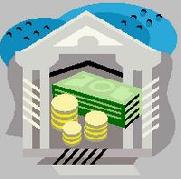
 |
|
| Financial Terms | |
| RFID |
|
Information about financial, finance, business, accounting, payroll, inventory, investment, money, inventory control, stock trading, financial advisor, tax advisor, credit.
Main Page: money, credit, financial, investment, inventory, accounting, payroll, business, |
Definition of RFID
RFIDAcronym for Radio Frequency Identification. It is the basis for small radio
Related Terms:Agency basisA means of compensating the broker of a program trade solely on the basis of commission Annual percentage rate (APR)The periodic rate times the number of periods in a year. For example, a 5% Annual percentage yield (APY)The effective, or true, annual rate of return. The APY is the rate actually Bank discount basisA convention used for quoting bids and offers for treasury bills in terms of annualized BasisRegarding a futures contract, the difference between the cash price and the futures price observed in the Basis pointIn the bond market, the smallest measure used for quoting yields is a basis point. Each percentage Basis pricePrice expressed in terms of yield to maturity or annual rate of return.  Basis riskThe uncertainty about the basis at the time a hedge may be lifted. Hedging substitutes basis risk for Blanket inventory lienA secured loan that gives the lender a lien against all the borrower's inventories. Bond-equivalent basisThe method used for computing the bond-equivalent yield. Compounding frequencyThe number of compounding periods in a year. For example, quarterly Days' sales in inventory ratioThe average number of days' worth of sales that is held in inventory. Discounted basisSelling something on a discounted basis is selling below what its value will be at maturity, Fixed price basisAn offering of securities at a fixed price. Flow-through basisAn account for the investment credit to show all income statement benefits of the credit Formula basisA method of selling a new issue of common stock in which the SEC declares the registration  Frequency distributionThe organization of data to show how often certain values or ranges of values occur. Gross domestic product (GDP)The market value of goods and services produced over time including the Gross national product (GNP)Measures and economy's total income. It is equal to GDP plus the income InventoryFor companies: Raw materials, items available for sale or in the process of being made ready for Inventory loanA secured short-term loan to purchase inventory. The three basic forms are a blanket Inventory turnoverThe ratio of annual sales to average inventory which measures the speed that inventory Investment product line (IPML)The line of required returns for investment projects as a function of beta Just-in-time inventory systemsSystems that schedule materials/inventory to arrive exactly as they are Net advantage of refundingThe net present value of the savings from a refunding. Net advantage to leasingThe net present value of entering into a lease financing arrangement rather than Net advantage to mergingThe difference in total post- and pre-merger market value minus the cost of the merger.  Price value of a basis point (PVBP)Also called the dollar value of a basis point, a measure of the change in Product cycleThe time it takes to bring new and/or improved products to market. Product riskA type of mortgage-pipeline risk that occurs when a lender has an unusual loan in production or Production payment financingA method of nonrecourse asset-based financing in which a specified Production-flow commitmentAn agreement by the loan purchaser to allow the monthly loan quota to be ReceiverA bankruptcy practitioner appointed by secured creditors in the United Kingdom to oversee the Reset frequencyThe Frequency with which the floating rate changes. Shortage costCosts that fall with increases in the level of investment in current assets. Small-firm effectThe tendency of small firms (in terms of total market capitalization) to outperform the Small issues exemptionSecurities issues that involve less than $1.5 million are not required to file a Tracking errorIn an indexing strategy, the difference between the performance of the benchmark and the Unique riskAlso called unsystematic risk or idiosyncratic risk. Specific company risk that can be eliminated Variance minimization approach to trackingAn approach to bond indexing that uses historical data to Cost basisAn asset’s purchase price, plus costs associated with the purchase, like installation fees, taxes, etc. INVENTORY TURNOVERThe number of times a company sold out and replaced its average stock of goods in a year. The formula is: MERCHANDISE INVENTORYThe value of the products that a retailing or wholesaling company intends to resell for a profit. UNITS OF PRODUCTIONA depreciation method that relates a machine’s depreciation to the number of units it makes each InventoryGoods bought or manufactured for resale but as yet unsold, comprising raw materials, work-in-progress and finished goods. Non-production overheadA general term referring to period costs, such as selling, administration and financial expenses. Product costThe cost of goods or services produced. Product marketA business’s investment in technology, people and materials in order to make, buy and sell products or services to customers. Product/service mixSee sales mix. Production overheadA general term referring to indirect costs. InventoryThe cost of the goods that a company has available for resale. Periodic inventory systemAn inventory system in which the balance in the inventory account is adjusted for the units sold only at the end of the period. Perpetual inventory systemAn inventory system in which the balance in the inventory account is adjusted for the units sold each time a sale is made. Specific identificationA method of accounting for inventory. accrual-basis accountingWell, frankly, accrual is not a good descriptive inventory shrinkageA term describing the loss of products from inventory inventory turnover ratioThe cost-of-goods-sold expense for a given inventory write-downRefers to making an entry, usually at the close of a product costThis is a key factor in the profit model of a business. product Basis PointOne one-hundredth of one percent Inventory Turnover RatioProvides a measure of how often a company's inventory is sold or bar codea group of lines and spaces arranged in a special by-productan incidental output of a joint process; it is salable, cost of production reporta process costing document that dollar days (of inventory)a measurement of the value of inventory for the time that inventory is held economic production run (EPR)an estimate of the number equivalent units of production (EUP)an approximation of the number of whole units of output that could have been grade (of product or service)the addition or removal of product process productivitythe total units produced during a period product complexityan assessment about the number of components in a product product contribution marginthe difference between selling price and variable cost of goods sold product costa cost associated with making or acquiring inventory productive capacitythe number of total units that could be product- (or process-) level costa cost that is caused by the development, production, or acquisition of specific products or services product life cyclea model depicting the stages through product line marginsee segment margin product varietythe number of different types of products vendor-managed inventorya streamlined system of inventory Basis pointOne hundredth of one percentage point, or 0.0001. Average inventoryThe beginning inventory for a period, plus the amount at the end of Book inventoryThe amount of money invested in inventory, as per a company’s By-productA product that is an ancillary part of the primary production process, having Finished goods inventoryGoods that have been completed by the manufacturing Joint productA product that has the highest sales value from among a group of products Moving average inventory methodAn inventory costing methodology that calls for the re-calculation of the average cost of all parts in stock after every purchase. Perpetual inventoryA system that continually tracks all additions to and deletions Product costThe total of all costs assigned to a product, typically including direct Production yield varianceThe difference between the actual and budgeted proportions Raw materials inventoryThe total cost of all component parts currently in stock that Work-in-process inventoryinventory that has been partially converted through the annual percentage rate (APR)Interest rate that is annualized using simple interest. percentage of sales modelsPlanning model in which sales forecasts are the driving variables and most other variables are shortage costsCosts incurred from shortages in current assets. unique riskRisk factors affecting only that firm. Also called diversifiable risk. Absolute AdvantageThe ability to produce a good or service with fewer resources than competitors. See also comparative advantage. Aggregate Production FunctionAn equation determining aggregate output as a function of aggregate inputs such as labor and capital. Basis PointOne one-hundredth of a percentage point, used to express variations in yields. For example, the difference between 5.36 percent and 5.38 percent is 2 basis points. Comparative AdvantageA country has a comparative advantage over another country in the production of good A if to produce a unit of A it forgoes more of the production of good B than would the other country when it produces a unit of good A. Its efficiency in the production of good A relative to its efficiency in the production of good B is greater than is the case for the other country. See also absolute advantage. Factor of ProductionA resource used to produce a good or service. The main macroeconomic factors of production are capital and labor. Gross Domestic ProductTotal output of final goods and services produced within a country during a year. Related to : financial, finance, business, accounting, payroll, inventory, investment, money, inventory control, stock trading, financial advisor, tax advisor, credit. |